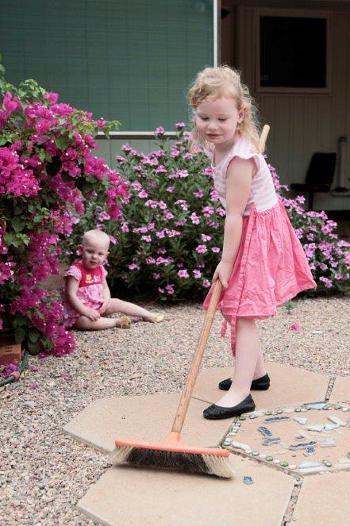Sweeping
Duration/age

Next time there is a pile of leaves to sweep up or it is time to sweep the kitchen floor get your child to help you. What part of the sweeping process will you ask your child to help with? Your child could sweep the leaves into a big pile with the broom while you use a dustpan and brush to put the leaves into the bin.
It has been very windy outside and there are lots of leaves on the ground. I am going to sweep them into one big pile. You can use the bucket to collect the leaves and tip them into the bin.
The floor is very messy because we made biscuits. While I clean up the table and get the dishes ready to wash you could start to sweep the floor with the big broom.
Talk with your child about where they can start. Will they start around the edges of the room and sweep towards the middle, creating one big pile? If the area is large they might need to create several piles of rubbish.
The kitchen floor is a small area. I think you can start at the edges of the cupboards and work towards the middle of the floor.
Sometimes when you sweep you need to move around and under furniture. Does this change the direction that you sweep? Do you need to lift up or move furniture so the broom can get underneath?
Before we can sweep up the leaves we need to put the garden chairs on the outside table.
Can you help me move the coffee table out of the way so we can sweep the floor? We can place it behind the couch while we sweep in front of it.
Materials you will need
- A broom
- A dustpan
Alternative tools
- A rake
Skills this activity improves
Why does this matter?
When your child helps you to sweep up they are exploring area and perimeter and developing language to describe position, location and movement.
As they help you to sweep they will be hearing and following directions that involve position, location and number. As they hear the direction they will be developing planning skills as they work out where to start, how many piles of rubbish to create and how to move around the physical space.
What does this lead to?
Encouraging your child to help with the sweeping up helps them to understand that they can use and move their bodies in many ways. Exploring how we can move our body in space helps children to navigate themselves through the environment and to develop spatial awareness.
As they explore the different ways their bodies move they are learning about measurement, space and size and how to move within and around objects.
As your child moves they’re using all of their body and senses. They are developing strength, control and coordination in all of their body parts including the large muscles in their trunk. Having a strong core, or trunk, is important as it helps children with good sitting posture.
Language to use
- Edge, middle, perimeter, area, sides, space
- Under, beneath, around, next to, against, behind, in front, on top
- Near, far, close Small, large, medium, big
- Number, several, one, many, lots
Questions to use
- What will happen to the pile of leaves if the wind blows?
- Do you have to start at the edge of the room when you sweep or can you start in the middle?
- Why do we make lots of small piles when the room is big?
- Why do we put the chairs on top of the table when we sweep?
Useful tips
- You might also like to take a look at the activities Let's get physical, Baby obstacle course and Up, over, under, through.
- For more information on your child's physical development see the Child Health Record - the Blue Book.
- The Department of Health also has some hints and tips about physical activity for children aged 0 to 5.
- Remember to talk to your child in your home language.
More ideas
Place a small dustpan and broom into your child’s cubby house.
Variation by age
Three to five year olds
- After the family has eaten, ask your child to help sweep up the crumbs from the kitchen table.
- Add different containers for your child to collect the leaves in. Which container will hold more?
- Time how quickly you can sweep up the mess.
Questions to ask
- How many piles of leaves will you make?
- If the bucket holds less leaves do you need to make more trips to the bin?
- Does it take longer to sweep if there are more leaves on the ground?
Language to use
- Time, fast, slow, quick
- Same, different, more, less
- One, many lots, several, number


